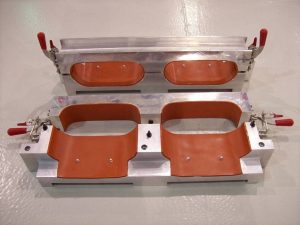This article is a general outline on how to implement a HASS program after a successful HALT has been performed and corrective actions have been completed for any weaknesses found during HALT. For more information about HASS, please read our blog, What is HASS Testing? For more information about HALT, please read our blogs
- What is HALT (Highly Accelerated Life Testing) and Why Perform HALT?
- What Kind of Failures Occur During HALT?
- What Equipment is Used for HALT?
- What is a Typical HALT Procedure?
Number of Samples
It is recommended to HASS as many samples as possible per batch. This will keep the screening cost per part to a minimum. The number of samples will depend on the fixtures needed to attach the units to the chamber table, monitoring requirements, and power requirements. The HASS setup should be optimized to work efficiently in a production environment.
Fixtures
The HASS fixtures should be manufactured for fast and efficient loading and removal of product. They should hold as many products as possible. The fixtures must be designed to support both vibration and thermal loading. They must be durable in order to withstand the fatigue damage caused by the repeated stresses that will occur over the fixture’s lifetime. The fixture needs to be lightweight, rigid, and have low thermal mass.

Functional Test Protocol
A Functional Test Protocol (FTP) must be performed on each sample undergoing HASS. The FTP must check that the product functions within predetermined specifications. The FTP coverage should be as comprehensive as possible for each sample under test. The FTP equipment will be located outside of the chamber.
Proof of Screen
Before starting a HASS program, a Proof of Screen must be performed first to demonstrate that the product has sufficient life after the HASS and to demonstrate that the screen does find product defects. After the Proof of Screen has been validated, production screening can begin.
It may be possible to determine the effectiveness of the HASS by seeding samples of the product with known defects. The seeded defects could include solder defects or typical manufacturing process issues based upon past history of similar products. Since, it is often very difficult to create a realistic seeded defect, mixed results may be obtained and judgment may need to be exercised as to whether the seeded defects are realistic. Field returned units may be good candidates for seeded samples.
The main objective of the Proof of Screen is to prove that the screen has not removed significant life from the products during HASS. The HASS profile should be repeated a minimum of 20 times, without failure occurrences. This shows that production units exposed to only one pass of the HASS profile, will still have at least 95% of their useful life remaining, or a maximum of 5% of their life was removed during one HASS screen.
Removing 5% of the life sounds like a lot, but in reality, the units would probably be able to withstand many more than 20 HASS cycles if a good job was done ruggedizing the product during HALT. Also, ‘life” is an accelerated life. The stresses in HASS are usually higher than normal use. To prove that they still have sufficient life remaining after HASS, it is recommended to run the same Proof of Screen units through qual testing or reliability demonstration testing after the Proof of Screen. If no failures show up, then it is not likely that the HASS would cause some long-term failure mode.
The Proof of Screen should be performed using the production HASS fixtures and the FTP equipment. During the Proof of Screen, the products should be instrumented with thermocouples and accelerometers to check that a sufficient temperature rate of change/uniformity has been achieved and that sufficient vibration levels are being transmitted to the product.
Production HASS
A specific production HASS procedure should be developed for each product. This is because the results from each HALT on dissimilar products may be different. Typical general requirements are listed below.
General Requirements
The HASS should be conducted by qualified engineers or technicians who are familiar with how to use the HALT/HASS chambers and the support equipment. All gauges, instruments, test equipment and measuring tools should have a current calibration status.
ESD Protection
Good ESD precautions should be used on any electronic product. At a minimum, an ESD gown and wrist strap should be worn when handling any product with exposed circuit boards. FTP test Fixtures shall be on a grounded stand. Connections to product shall be carried out using ESD precautions.
Report
The reporting depends upon each product and upon each customer’s requirements. Typically, a Pass/Fail report or certificate would be issued with each product or batch of products. The pass/fail report or certificate should list the product serial number, a pass or fail status, and a summary of the failure mode if applicable at a minimum.
Disposition
The disposition depends upon each product and upon each customer’s requirements. DES’s typical disposition procedure is as follows:
- All products are tagged with a Green Passed HASS label or a Red Failed HASS label as appropriate. This may be stuck on the product or the outside of its packing.
- A HASS certificate will be inserted with each unit inside of its packing.
Corrective Action
Finally, a system to determine root cause of problems, develop corrective actions and verify corrective actions should be instituted. Typically, a formal system such as FRACAS is implemented. FRACAS stands for Failure Reporting, Analysis and Corrective Action System. FRACAS is sometimes implemented using computer software and provides a process for reporting, classifying, analyzing failures, and planning corrective actions in response to those failures.
DES has over 20 years of experience performing HALT/HASS testing on a variety of medical, commercial, industrial and military products. For more information on HASS, HALT or other testing services, contact DES or call 610.253.6637.